Anno Domini 2017
If Goodbye Trello, Hello Todo.txt didn’t reveal my roots as a day-planner
fanatic then I’m sure this post will.
This week, I sadly retire the Franklin Planner that has been by my side for the
last twelve years. I never really followed the Franklin method, and over time my
personal day planning strategy has relied less and less upon it’s features. The
notes pages were never quite large enough to fit the reams of notes that I need
for my work. The hourly planning lacked the ability to schedule in twenty-four
blocks (who in this day and age keeps strictly to 9-to-5?). And the hundreds of
detailed todo items, reminders, and recurring calendar events are best rendered
computationally rather than by hand. Over the years,
the Franklin Planner saw less and less use until it eventually become an
afterthought to my daily planning regiment.
As of late, I have been trying to consider alternative solutions to GTD in order
to get a more fluid style of day planning that respects the flexibility in time
scheduling and necessity of play in creative work. The rigidity of keeping to a
fixed hourly schedule, and a general movement towards a kind of fixed daily
routine, has left me thinking of my time less in hours and more as four to five
work blocks; an hour for breakfast, lunch, dinner, and bed respectively; and a
single block of after-dinner time for creative or cultural pursuits.
Bullet Journaling
My attention has turned Bullet Journaling as a planning method that
incorporates a the kind of looseness and play that I am looking for in my
planning. The Bullet Journal does not replace the todo.txt cli, but rather
augments it. A large part of my day is routine and need not be recorded other
than to generate an automatic reminder and be marked done. There are perhaps
twenty to thirty items each day, varying by day of week or time of month that
appear magically in my todo list. Likewise, managing my backlog of some three
hundred house chores, creative projects, and writing prompts could fill several
hand written journals.
The Midori Traveler’s Notebook
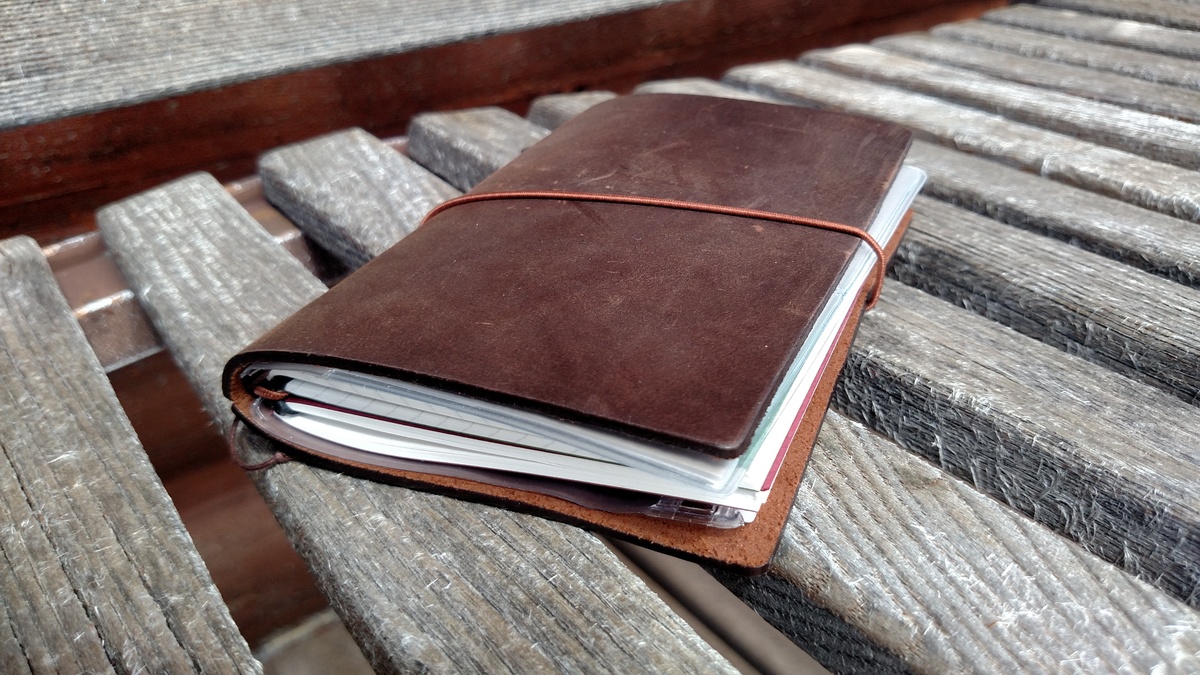
I received, form my birthday, a Midori Traveler’s Notebook. This wonderful,
passport-sized leather notebook solves so many of the Franklin Planner’s
problems: it’s light and pocket sized so I can carry it on me at all times, the
pages are 25-lines high and open to my creative interpretation on how they will
be used, the classic band-bound design allows me to easily store loose sheets of
paper such as receipts or printed and folded shopping lists. Once more, it just
looks and feels great to have in my hands. My passport-sized item has two
bullet-guided notebooks inside (my estimate is that each notebook ought to last
me roughly a month), and I carry a binder clip to hold it open to my schedule
for the work day.
My Method
The method that I am about to describe is highly experimental. Over the next two
months, I am forgoing the Franklin Planner to see if some form of bullet
journaling could take it’s place.
The bullet journaling method needed some adaptation for my usage. First, I am
not attempting to create a journal of all my tasks in a day. Such would merely
be replicating the logging that I get from using Todo.txt. Rather, this is a
birds-eye view of the most important tasks that I want to complete or progress in
the day and a simple layout of those tasks into my block schedule.
The general bullet journal idea of placing a topic on the page with subsequent
sub-items remains and will fill in the side pages. As will an index at the
beginning of each notebook. The small size (remember we have only 25 lines to
work with) of the notebook necessitates brevity and focus on only the most
important items.
Syntax
The bullet journal syntax remains close to the original. We have three types of
items: a task, an event, and a note. I add to this, the project which is a kind
of aggregation of tasks. Each is marked in the journal as such:
- (•) A task
- (+) A project
- (o) An event
- (-) A note
Each of these items can then take one of five states:
- ( ) Incomplete, not occurred, or null
- (•) In progress
- (✓) Completed
- (x) Canceled
- (>) Bumped, but not scheduled
- (<) Scheduled
The Daily Template
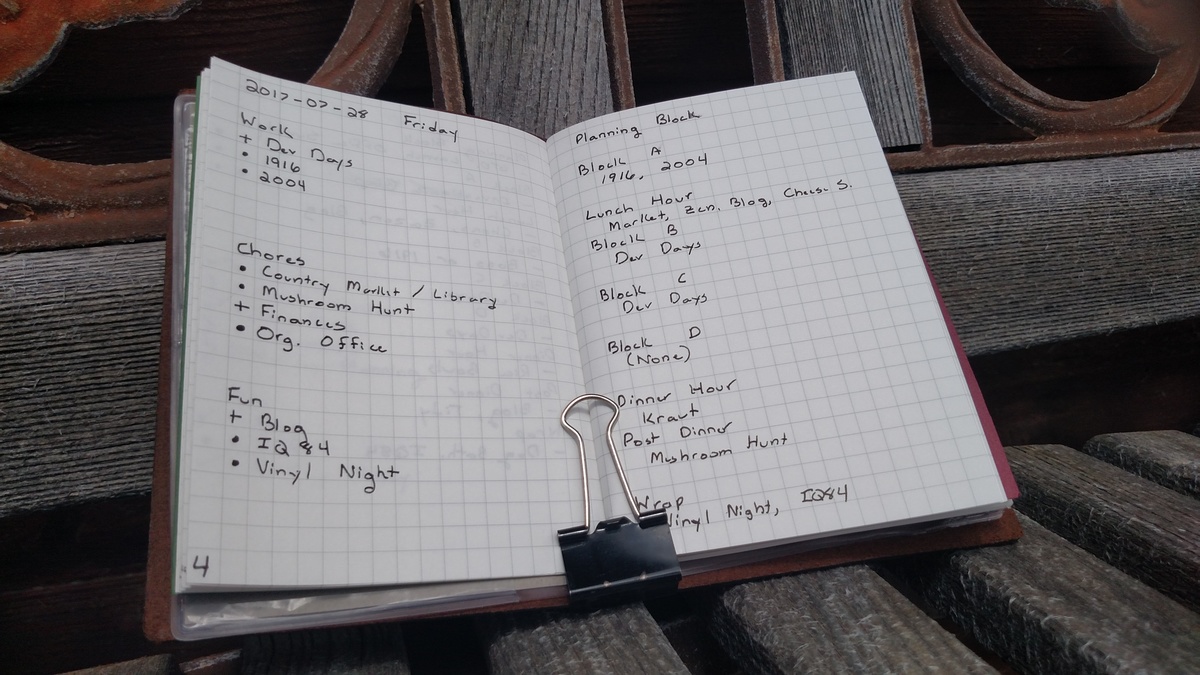
The daily template is a full spread in the journal, except for the weekend days
of Saturday and Sunday (and probably holidays or vacation days) which make use
only of the right page.
The Right Page:
- The full date in the upper right along with the day of the week
- The page is divided into three sections of six lines: work, chores, and fun
- The spread is numbered in the lower left
Experience tells me that it is better to keep a short list (typically five or
less) goals for a day than a long list of goals. Short lists make the anxiety of
what to focus on vastly easier. Likewise the three contexts of work, chores, and
fun are easily separated in my routine. I am either working, getting some bit of
necessary drudgery out of the way (chores), or I am free to do something fun.
Also, if fun isn’t expressly earmarked then I am often given to letting chores
expand until it uses up all of my time. Putting some bit of fun (a movie,
continuing a book or game) on the same page as work and chores gives it the
same level of import and thus I am more likely to put away my tools at the end
of the day and leave time for leisure.
The Left Page:
The left page is broken into nine blocks of time with each work block and
post-dinner getting three lines and all others getting two lines:
- Planning Block (Roughly 08:00-10:00)
- Work Block A (Roughly 10:00-12:00)
- Lunch Hour (Roughly 12:00-13:00)
- Work Block B (Roughly 13:00-15:00)
- Work Block C (Roughly 15:00-17:00)
- Work Block D (Optional, roughly 17:00-19:00)
- Dinner Hour (Roughly 19:00-20:00)
- Post Dinner Block (Roughly 20:00-21:30)
- Evening Wind Down (Roughly 21:30-23:00)
Beneath each header, I jot very briefly the main task be it from the right page
or perhaps some routine item on my Todo.txt list that I hope to complete or
progress through that period. I may also note specific meetings or appointments
that begin or cross that block and their times found in my calendar.
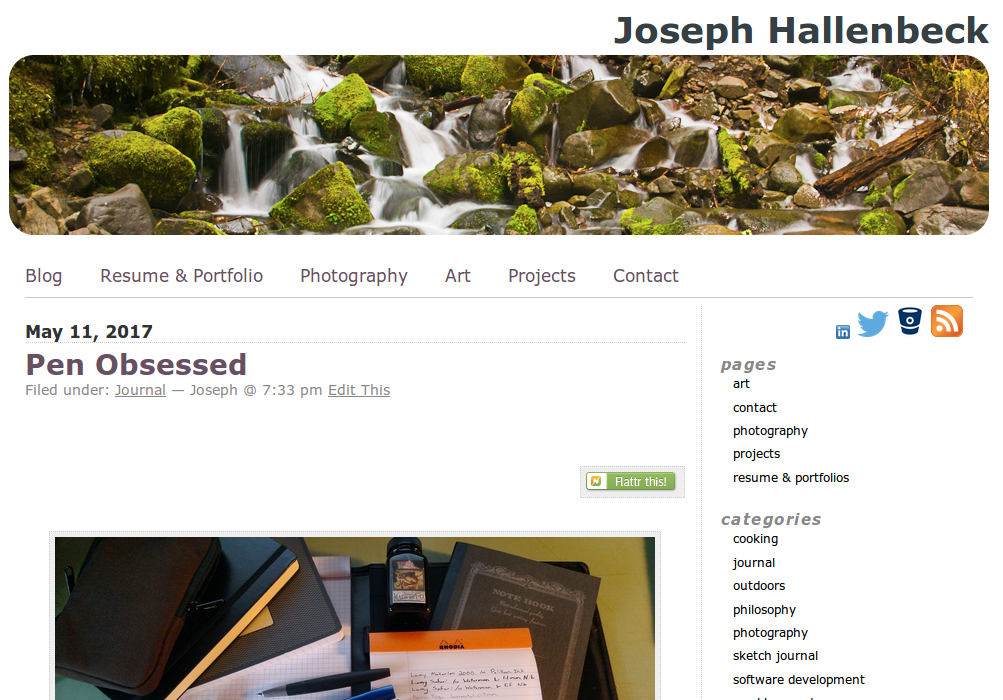
About two years ago I started muddling on a small project to update this blog.
At the time, I felt that there was a need to create something that better
reflected both my growth in design and front-end sensiblities but also my
perspective on how we ought to approach our relationship with the web.
The blog itself has gone through many fine iterations since college. For a
while it served as a platform for attracting employment interest. Now, that I am
established, it is slowly becoming a platform for posting “anything and
nothing” that crosses my mind. The get-me-hired aspects of the blog will
probably be jetisoned onto some new, yet to be made site.
The Website As A Document
The web page is really a kind of virtual typesetting. We take the raw document
in a UTF-8 encoded text with perhaps some simple markup like Markdown, and then
set that document to build a complete html page. Had the medium been different,
say if we were to set to print, then the output could be a PDF, DOCX file, or
even a different markup type (e.g. Latex).
As I have grown as a developer, I have come to the slow realization that the
relational database, while a great back-end for serializing relational objects,
makes a rather poor document data store. Look at my old webcomic, Dreamscapes,
which is currently offline because the CMS it was built upon doesn’t support
PHP7. If we really care about our documents then this becomes a major concern.
In order to edit, view, or generally interact with a document stored in the
RDBMS we must have a full stack of applications that can work together and work
on a given platform. MySQL must be installed and configured to work with the
HTTP server and the HTTP server must support the PHP version of the CMS. This is
a lot to maintain in order to simply read a document. Our ability to archive
and retrieve a document becomes a mounting concern as time progresses. If we
want to retrieve a document that is in such a system ten, twenty, or thirty
years later we may find ourselves first wading through the labourous task of
tracking down and compiling ancient software and virtualized systems just to
read what could have been stored in a text file.
In light of these thoughts, I am moving all of my document-based sites to
static site generators.
The static site generator (in this case Jekyll), respects this idea that an
article on a website is a representation of a document. We can seperate the
repositories of content and layout into two different respective Git
repositories. When I am working on the layout, I can work in programmer-mode and
when I am working on content, I can work in writer-mode.
The article, is thus a document in my documents directory. I can write in it
using the same text editor that I use for any textual document (Vim). I link it
to the Jekyll posts directory to be typeset for the web, or I can run it through
Pandoc to typeset it for print. If I ever wanted to self-publish a book, I could
use these documents as the source to typeset into a series of chapters for an
e-book or volume for Lulu.
Responsive & Simple Design
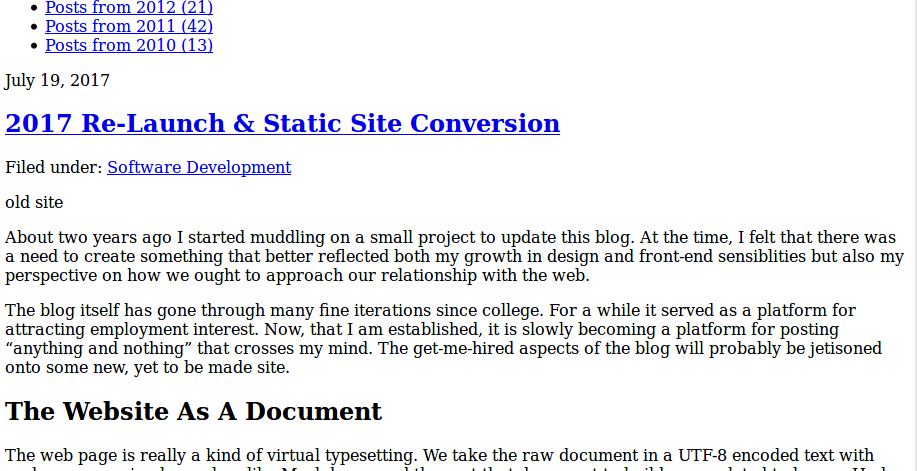
The new design is no radical departure from my last layout. Overall, I liked the
old layout well enough. Unfortunately, it had a few rough spots: poor display on
phones, the typical wordpress cludge of spaghetti html, and an inconsistent
approach to typography.
The new layout starts with the styles outlined on the Better Motherfucking
Website and then applies a very minimalist layer of front-end frameworks
(Bootstrap and FontAwesome) to achieve a responsive layout that resizes nicely
from desktop to phone. I took great care at implementing the correct HTML5 tags
and stylesheet properties for a rather simple design. The result is that the
site looks good and is fully functional even if we remove the stylesheet. Last,
I carefully reviewed the text blocks possible via Markdown and Kramdown syntax
and crafted a series of test articles displaying a wide variety of ways those
text blocks could be combined. Working through these test articles I constructed
a consistent style that when applied to my existing articles resulted in a much
more readable body of text.
Comments are gone. Swept away. Lost to some MySQL dump in the back ups
directory. This was a decision that took some debate. I like the idea of a
distributed collection of communities discussing away on some topic. Yet, I am
not interested in moderating and maintaining such a community. These communities
often devolves into a cult of personalty, or which would probably be my case,
abusive flame wars.
In over a decade of writing on the web, I can count the meaningful comments made
on my sites on one hand. When I look at blogs that do recieve some staple
comments with each post, they often become a dialogue between the creator and
questioner with no real benefit to any larger community.
It seems best that discussion about some post or topic be moved into dedicated
communities for discussions, that is Hacker News, Slashdot, or the
healthy collection of smaller bulletin boards that litter the internet. If my
words have moved someone so passionately that they must talk with me, my e-mail
and twitter handles are available in multiple locations on the site. Or if you
wish to rant at me at length, you can always start your own blog.
Kick Big Brother to the Curb
Google in all of it’s various forms is similarly banished. I would still like to
show up in Google searches, but I have no interest in being a platform to
serving up my readers to their big-data engines nor polluting my site with
low-quality advertisements.
Analytics, by itself, seems a rather harmless bit of data collection. I fondly
recall getting my first page-hit counter working on my geocities site over
fifteen years ago. I am still amused to see how many people are reading an
article and their general geographic distribution. Alone, this is just a silly
whimsy, but collectively it becomes a problem. Targeted digital marketing is the
bane of the internet and from it stems an endless flow of poorly written
listicles and click-bait articles by authors principally interested in hitting
the SEO bingo.
Which brings me next to the problem of ads and internet monetization. Shortly
after college I explored the potential of online writing for employment. I found
that the vast majority of online writing is paid for by advertisements and
advertisements provide a most perverse form of incentivisation. The author
quickly finds themselves writing for volume on topics selected for return on
investment rather than passion. The ads themselves bring almost no return, and
clutter up an otherwise nicely looking site while undermining the credibility
and relationship between author and reader. The best writing online is either
passion, paywalled or patronage (be it Patreon or academic).
Thus, analytics has moved to a self-hosted Piwik install. I could get the same
data looking at my server logs, but I do like a nice user interface for my
amusement. DNT honoring, is of course, turned on.
[Patreon][] strikes me as one of the few honest methods of monetization for an
independent creative on the internet. As such, I have set up a Patreon page and
would find it vastly more validating should someone someday choose to donate a
dollar on it then any sum of money that advertisements could draw. That said, I
do not imagine myself putting too much effort into constructing elaborate tiered
rewards or crowdfunding campaigns. Gone are the days that I envisioned a career
as a professional creative. I lack the charisma for cultivating a group of
followers and I lack the focus to become well regarded in any particular niche.
The day job covers me quite well, leaving my creative asperations to follow
whatever path amuses me. Any earnings, I would imagine, would simply be passed
along to other creatives on the site.
Licensing

Last a word on licensing. Dr. Godfried-Willem in The Absurdity of Copyright
points out the futility and logically indefensible hurculean efforts that
industry takes to secure intellectual property. Ultimately, the internet is a
platform for speech and is best suited as a space for promoting oneself and
one’s ideas rather than a marketplace for buying and selling fictitious property
claims. As such, I have placed the source code for this site under The MIT
License and the content of the website under the Creative Commons
Attribution-ShareAlike License.
[Patreon]:
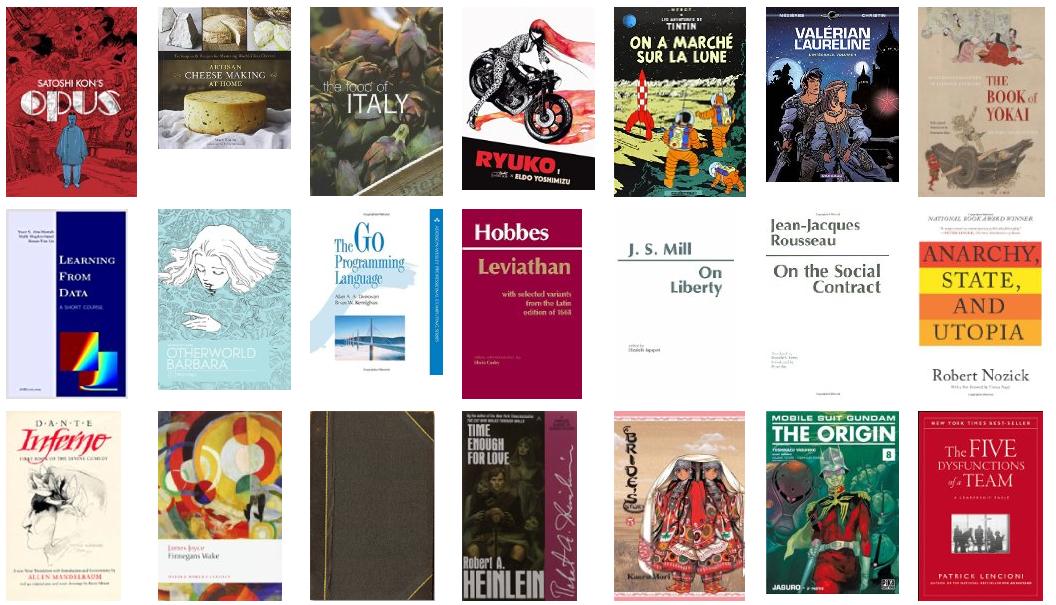
“One cannot read a book: one can only reread it” – Nabokov
I woke this morning thinking about re-reading The Lord of the Rings. The last
stab at the thick volume I made while at Oxford in 2008. A childhood friend
reads the entire thing on an annual basis. Which brings me around to another
question. If I examine the entirety of my library and was given the choice of
only a select few books to read and re-read for eternity which volumes would
that entail? It is said that the quality of a litrary work is measured in our
ability to glean something anew from each reading.
Certainly there are many a book and a film that has touched and moved me greatly
and yet, I would not go back and read it again. Honey & Clover, for example,
was paramount in my decision leave DigiPen for Augustana. Yet, in rewatching, it
has never recaptured the same motive power.
This list then is a kind of “desert island list.” A list of works so profound
that if restricted to only those works on a deserted island I could potentially
get by. It is also the list of works that I could potentially see myself reading
and re-reading every five years into my geriatry.
Books (Novels, Short Story, and Graphic Novels)
The novel is an easy one to figure out. Which volumes have I returned to time
and again? Some of have certainly fallen off the list. C.S. Lewis was wonderous
as a child but what once seemed like playful allegory now feels too much like a
club.
The Classics
- Beowulf translated by Seamus Heaney
- The Odyssey by Homer
- Gilgamesh
- The Holy Bible
The Modern Fantasy
- The Lord of the Rings by JRR Tolkien
- The Hobbit by JRR Tolkien
- The Silmarillion or The History of Middle Earth by JRR Tolkien
- The Works of Lovecraft
- Dune by Frank Herbert
- The Dungeons & Dragons Rulebooks (AD&D, 3rd, and 5th Editions)
The Graphic Novel
- Nausicaa of the Valley of the Wind by Hayao Miyazaki
- Solanin by Inio Asano
The Literary Books
- On the Road by Jack Kuroac
- Child’s Play by Ichiyo Higuchi
- Snow Country and Thousand Cranes by Yatsunari Kawabata
Philosophy
What is worth re-reading in Philosophy is far too long of a list. I submit instead
those volumes from my undergrad that I find worth returning to as they provide a
rather sound foundation for further reading.
- The Complete Works of Plato
- Nichomachean Ethics by Artistotle
- Confessions by St. Augustine
- Summa Theologica by Thomas Aquinas
- Meditations on First Philosophy by Descartes
- An Essay Concerning Human Understanding by Locke
- An Enquiry Concerning Human Understanding by Hume
- Critque of Pure Reason by Kant
- Prolegomena to Any Future Metaphysics by Kant
- The Phenomonology of Spirit by Hegel
- Fear & Trembling by Kierkegaard
- The Portable Nietzche
- Being & Nothing by Sartre
- The Rebel and The Myth of Sisyphus by Camus
Film & Television
Rarely do I return to a film and almost never teleivison. A handful are
regulars, Star Wars, The Lord of the Rings, and Labyrinth where all
watched repeatedly in my youth. The collected works of Miyazaki, Kirasawa
and Satoshi Kon are all revisited on occassion. A handful of anime I would
like to take the time to rewatch as they were all very formative in my youth.
Yet, how well they would stand up on a rewatching remains unknown.
Film
- Star Wars
- The Lord of the Rings Trilogy
- Night on the Galatic Railroad
- Monty Python and the Holy Grail
- Directed by Miyazaki: Castle in the Sky, My Neighbor Totoro, Kiki’s Delivery
Service, Porco Rosso, Pom Poko, Whisper of the Heart, Princess
Mononoke, Spirited Away, Howl’s Moving Castle
- Directed by Kirasawa: Seven Samurai, Rashomon, Ikiru, The Hidden Fortress, Yojimbo,
Sanjuro, Throne of Blood
- Directed by Satoshi Kon: Perfect Blue, Millennium Actress, Tokyo Godfathers,
Paprika
Anime & Television
- Cowboy Bebop
- Samuarai X
- FLCL
- Serial Experiments Lain
- Mushishi
- Kino no Tabi
- Red Dwarf
- The Twilight Zone
Games
The vast majority of games have no narrative arc. How can I return to Counter
Strike? When I examine narrative single player games though, I find myself going
back to Miyamoto’s early games: Mario and Zelda. Few titles from that era
held up with age, and fewer modern titles are worth a second look. Yet, I must
admit that I have probably gone back to re-play none of these games in the last
decade.
- Super Mario I, II, and III
- Super Mario: Yoshii’s Island
- Super Mario 64
- Super Mario RPG: Legend of the Seven Stars
- The Legend of Zelda: Link to the Past or Link’s Awakening
- The Legend of Zelda: Ocarina of Time
- Chrono Cross
- Shadow of Collossus
- Ico
Honorable Mentions
There are a few volumes that I have read multiple times, but upon later reading
in life, I do not feel the same spark and will probably not return:
- The works of Mishima
- The works of Murakami
- The works of Bill Waterson
- The works of C.S. Lewis
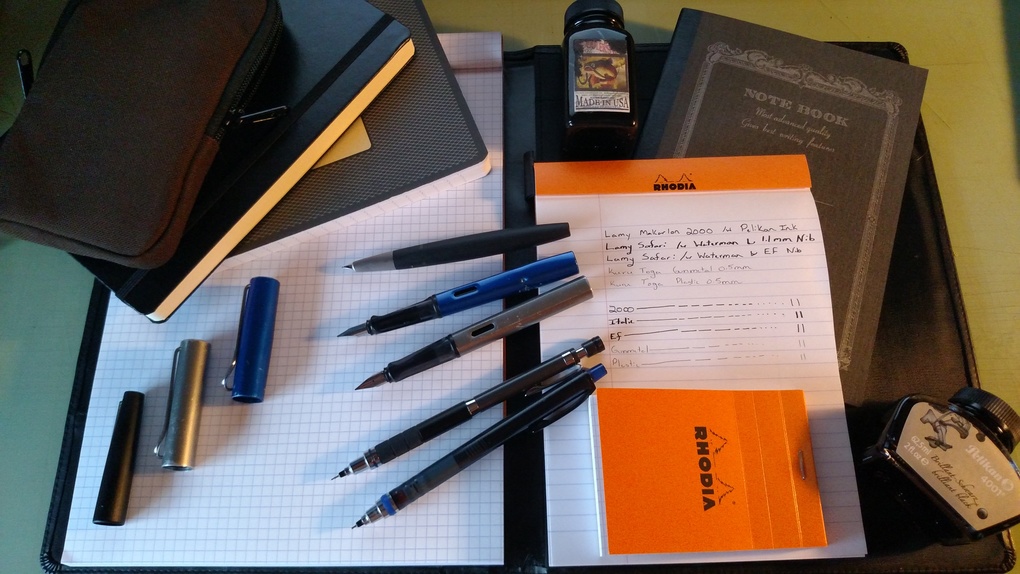
Lately, I have been thinking a little too much about my writing implements. You see, I have always been slightly picky about my writing tools and a little to amused by nice paper and inks. The stationary aisle in any store is my treat. As such, I have collected far too much odd-and-end pens and pencils over the years. An assortment of half-filled notebooks before I moved on with anticipation to a fresh clean notebook. So for several years now, I have resisted the temptation towards new notebooks and now, as I open my paper drawer and see only a handful of fresh graph and memo pads, it is time to venture out in search of fresh supply.
Concerning Pens
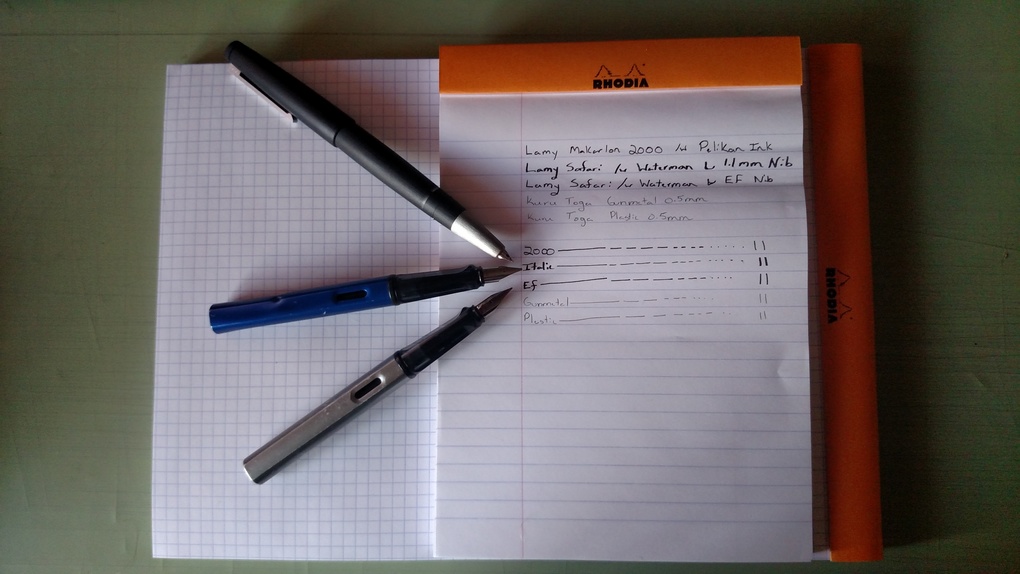
From top to bottom: Lamy 2000 Makrolon EF, Lamy Al-Star Italic 1.1mm, Lamy Al-Star EF
My writing implements, I am most particular. Namely, I like a pen or pencil to have some heft or volume to them so I can feel them in hand. My daily writing pen needs a fine nib. Scratchy is alright, but really my vowels tend to mush into the same loopy shape, so extra fine is a must. On a pencil, I judge them by how frequently the lead breaks and how consistent the line.
In college, I switched from roller-ball pens to fountain pens. My first, was a Lamy Al-Star that I unfortunately lost at Jewel Cave. Since then, I’ve followed up with two more Al-Star pens, each with their extra fine nibs. The lines on the Lamys seem equal in fineness to my old roller-balls, run smoothly, and create a consistent line.
Two unfortunate side steps in pen purchasing. First, I got a very nice Parker Sonnet when I graduated. The Parker, despite costing five times as much, was vastly inferior to my cheaper Lamy pens. The pen looks beautiful, but the nib struggled to provide consistent flow. Eventually, I gave up on it. It remains a desk-drawer bound pen. The later mistake was to purchase a Noddler Ahab. I thought the tinkering would be fun. Yet, again. The nib either flowed too much or too little. In to the desk drawer it went and I back to my Lamys.
Recently, I stepped up to a Lamy 2000 Makolon EF. At it’s price point, it probably will never leave my desk while the Al-Stars remain my field pen. I feared that, like my experience with the Parker, that the additional cost would be wasted. Yet, the extra price on the 2000 was quite worth it. The EF is finer than the Al-Star EF, yet just as smooth. The built in pump vastly less messy. The uniform, line-less body beautiful. The heft, and volume of the pen comparable to the Al-Star.
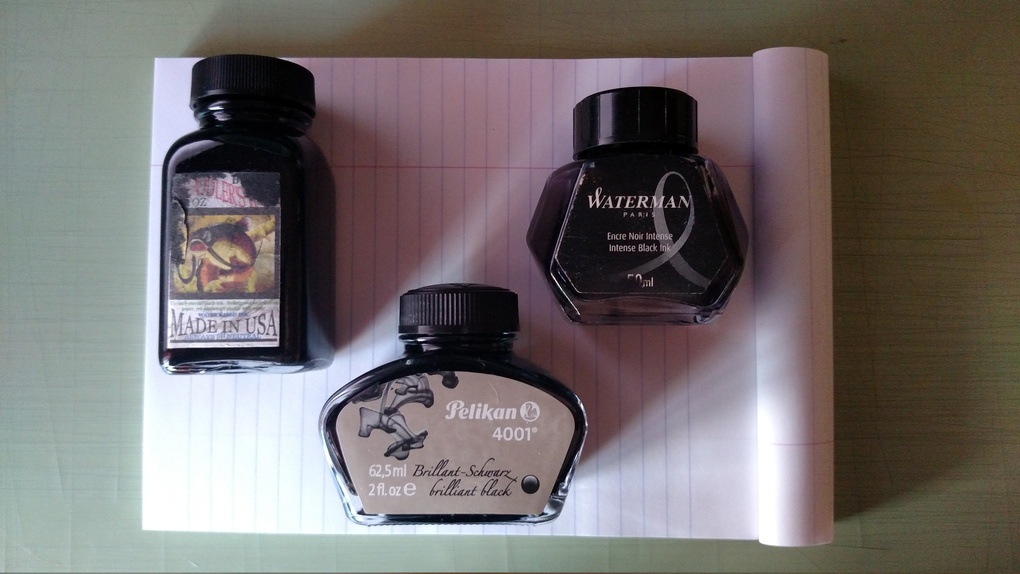
From left to right: Noodler’s Black, Pelikan 4001 Brilliant Black, Waterman Black
Ink wise, I would shy away from the Waterman inks. They seem to bleed and are rather lustless. Yet, for years I switched between Waterman and Pelikan based on the price at hand. Pelikan, was vastly the preferred ink. I could always tell a piece that had been inked by one or the later as it always seemed darker and more refined on the page. That said, I am venturing into other inks. Noodler black seems to be highly recommended, although I have not tried it.
Concerning Pencils
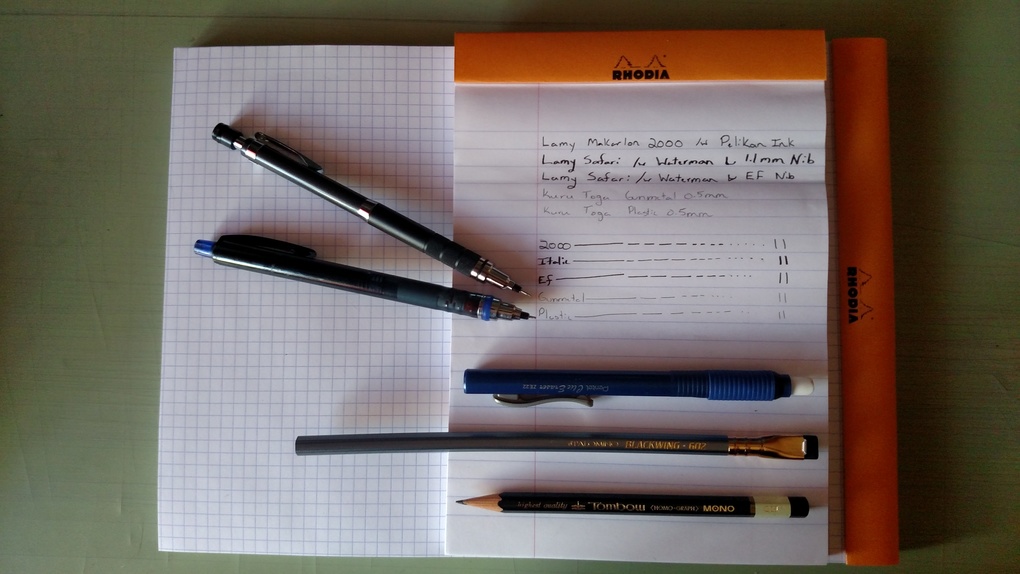
From top to bottom: Uni Kuru Toga Roulette Gunmetal Black, Uni Kuru Toga Starter, Pentel Clic eraser, Palomino Blackwing 602, Tombow Mono
Concerning mechanical pencils, I always write in nothing wider than 0.5mm. I once carried a GraphGear 500 by Pentel. The pencil feels very solid, but the tip of the lead is often crushed. By chance, Research Square gave me a very nice mechanical pencil when I started. A Uni Kuru Toga, starter. The Kuru Toga writes very consistently, and I rarely break my lead with it. The only downside is that for the longest time I could only find the flimsy plastic version in stores. It lacked the heft that I wanted in a writing utensil. Fortunately, I found a metal version for sale on Jet Pens, and am now very pleased.
A last note on mechanical pencils. I have given up on using their erasers which must be changed out too frequently and whose replacements are hard to find. Rather, I carry Pentel click eraser which is just is just a handling tube containing a four-inch long extendable eraser.
Wooden drawing pencils are another matter. In my art courses, I favored Tombow’s wood drawing pencils. They feel better than what could be found at Hobby Lobby. Yet, they do not match up with the Palomino Blackwing 602. Once I purchased those, I was completely sold on ever wanting another drawing pencil. Honestly, I still have a lot of Tombows around, and do use them on the rare occasion that I’m not inking a drawing. At this juncture, if I want to draw with a pencil, I reach for the 602s.
Concerning Brushes

From top to bottom: Winsor and Newton Series 7 Size 0, Winsor and Newton Series 7 Size 1
Last, there are brushes. In these, I use for inking drawings, ink washes, and watercolors. Oil painting always seemed like too much of a production and the aesthetic of oils unappealing. A great deal of texts recommended the Winsor & Newton Series 7 as an excellent brush. Yet, a lot of reviews online are mixed suggesting that the quality for Series 7 can be rather variable. That, and they’re nearly impossible to find in a local store. I stumbled upon them in Seattle’s university district when I was unemployed and shouldn’t have been spending such money. Yet, I walked out with a number of the brushes. The quality, in comparison to your run-of-the-mill Hobby Lobby brush does show. Whether they are better than other Kolinksy Sable brushes out there, I wouldn’t know.
Concerning Everything Else
Then there are those instruments that fill my drawing drawers: erasers of various sizes and types, Copic markers, colored pencils, charcoal, vine charcoal, acrylic paints and brushes, highlighters, permanent markers, watercolor paints, brush pens, and dip pens. Only the last item do I have any kind of opinion on and that being that I have longed used whatever nib holders were available and favored the extremely finest speed ball nibs. Yet, I have long suspected that better nibs and holders could be found if I put a mind to it.
The Breakdown
Solid Writing/Drawing Implement Recommendations
You simply cannot go wrong with the following tools.
Writing/Drawing Implement Suggestions
These items I like, yet am not completely certain on.
I have heard nice things about the Japanese Pilot fountain pen series. Namely, that they are even finer than the Lamy EF nibs. Yet, their prices have kept me at bay.
Implements Under Exploration
These items, I have yet to really explore or have any kind of solid favorite, or even a vague notion of likes and dislikes, but would like to get a more solid foundation with:
- Dip pens (inks, holder and nibs)
- Brush pens
- Watercolor paints
- Colored pencils
- Charcoal
My annual retrospective is running a bit late this year. Probably because there
has been so many big life-changing developments in the last year. This has
inspired a great deal of introspection and anxiety. I describe 2016 as a very
necessary year. Not an enjoyable year, but a year where I was mostly
reactionary to a long sequence of unavoidable events that started with the
totaling of Ford Explorer in late 2015 and leading up to the eventual
first-home purchase.
Personal Highlights
Existentialism
The year of necessity has become my description of 2016. Everything happened
because it had to happen. There was little agency involved, but rather a great
tide swept me along. It took me from Wyoming to Arizona. It took me from
Clifton to Alpine. It put me into a mortgage. It put me into a car loan.
In between, I found some time to read, game, and watch thirty some films.
Somewhere around the midsummer I fell into a kind of fugue where all my hobbies
and activities started to feel more like chores than entertainment. I read,
gamed and watch films out of habit rather than enjoyment. Nihilism set in, I
looked ahead on life and just saw an infinite number of books to be read and
realized that the act of reading was itself meaningless. Life seemed an
infinite set of tasks, each task leading to yet another task, and no task
itself intrinsically meaningful.
Since settling in Alpine, my mind seems more settled and at ease, but one thing
that came of this is a realization that there is simply too much to do in
adulthood and not enough time to commit to all of it. More importantly, my time
is often consumed not by what I want to do, but what I need to do. That I would
be better off setting aside all commitments and evaluating them. Do I receive
commiserate value for my time in work (existentially that is, not monetarily).
Would that time be better spent in some other pursuit? How much enjoyment do I
get out of a perfectly folded closet?
Redundancy in Task Management
I like lists. I like checking things off lists way too much. This can, at times
become overdominating to my lifestyle and at the start of 2016, I started to
realize that I was drowning in lists!
A couple years back, I started to keep a daily work log to remind myself of the
work that I had done over the year. I consolidated that work log each sprint
into a sprint log, and each quarter into a quarterly log and each year into an
annual log. I documented the work I did both in TimeKeeper, in
Trello/Todo.txt, and then again in my summarizations.
The redundancy had to be eliminated. With this in mind, I stopped keeping a
daily log. Now, I keep my lists in Todo.xt and my time in TimeKeeper. I do make
a very short Sprint review every two weeks but I focus on only documenting
extraordinary events and future plans instead of the minutia of everyday
living. The quarterly log is a summary of those extraordinary events and the
annual review a further summarization. There is no need to go back and review
past todos and past sprint logs.
One of these days, I will write a nice, long post about my task management and
note-keeping systems.
The Permanent Southwest Trip
The move to Three Way could best be described as an adventure. We started on
brisk -26 degree evening in Jackson, WY. My trailer jack broke off in my hand.
I was able to lever it onto the hitch using a spud bar only to have it bounced
off in heavy traffic in Salt Lake.
Three-Way was our new home on the intersections of Hwy 78 and 191. Home to a
corner store, the USDA and the Department of Transportation. We lived for the
first two months out of a Fema Trailer. At thirty feet long, it felt cozy but
at times also claustrophobic. Jess walked the hundred yards to work each
morning. I worked off a cell tower. In the evening we walked the dogs down to
the Airport and back trying our best to avoid the occasional rattle snake and
overly curious horse.
Come March, we found housing on a six acre property just a short walk away from
the Gila River. As a condition of renting, we put in a floor and signed a six
month lease hoping to make a more permanent home for some time.
Greenlee County, of which there is only really two towns: Duncan and Clifton
proved a strangely magical location. Through the spring we were visited by all
kinds of exotic birds, lizards, snakes, tarantulas and insects the like of
which I have never seen before. I killed no less than dozen scorpions in the
house and one rattlesnake that wandered too close to the porch. At night,
javelinas roamed about in the yard. The summer proved far too hot for me –
reaching 120 on one day. I confined myself to the office, the only room with an
air conditioner, and slept through most of the afternoons while working late
into the night. The August rains helped some and soon the washes around the
house swelled and flowed.
In the end, Greenlee County proved a short lived adventure. A promotion was in
store for Jess moving us up the Mogollon Rim to higher elevations, cooler
climates, and more familiar surroundings. For the long-term this is perhaps
best, but Greenlee is a mere two hours away at any time, inviting us back to
the deep desert whenever we tire of mountains and prairie.
The Alpine House
Greenlee was exotic, exciting, but altogether too hot and alien of a climate
for me to see any extended stay. We found ourselves, by midsummer, looking
northwards to Alpine, AZ. There, at an elevation of 8,000 feet the climate was
far more temperate. The summer reached only the low nineties, the nights stayed
cool, and in the winter there was snowfall. The hiking was excellent, the
forest a mixture of aspen, oak, and ponderosa much like my beloved Black Hills.
Jess applied, and was offered a promotion in the district. The town, of a mere
100 people in the winter, proved a tough nut to crack for rentals. However, we
quickly fell in the love with the area. Springerville proved a treasure trove
for shopping. Between Safeway, Western Drug, and two hardware stores we were
well set. The location, a perfect basecamp for the southwest. In five hours we
could be in Moab, Sante Fe, Tuscon, Silver City, or the Grande Canyon. In the
winter, we found snow shoeing available above 10,000 feet at Hannagan Meadows.
If we grew tired of Winter, a twenty minute drive put us in the Blue and a two
hour drive put us on the desert floor.
By luck, we stumbled upon a cabin that was in our price range. Built in 1962,
it sat on the back of a quarter acre lot a mere quarter mile walk from the
Forest Service. Three bedrooms, a single bathroom, and an expansive Arizona
room that looked out over the valley and up to South Mountain. Only minor work
required, a new metal roof, a wood stove added to the living room, venting for
the bathroom and dryer and it was soon ready for the long term.
Granted, we first had to run the gamut of the mortgage which proved a nightmare
that consumed two months of my summer. An employment paid move from Three Way
up the hill, unpacking, and the long run of house guests who always arrive
shortly after such ventures.
Chickens
May was occupied by chickens. A strange thing to occupy a month. We picked up
six chicks from Tractor Supply near the end of the season. In the spare bedroom
we set up a brooder made from cardboard boxes. There the chickens grew for
another month while I busied myself with building a coop.
I got a design off of Catawba Coops detailing a nice A-frame style chicken
coop and made some modifications for the climate and potential threats. The
wooden roof, I swapped out with metal. The fencing I made smaller to keep the
snakes out. The project consumed the weekends for over a month. In the end, we
got five hens and a rooster out of the mix. The rooster died before fall, but
the hens started laying eggs around September and kept up almost until
Christmas.
The Places I Did Go
The change of region brought with it the opportunity for exploration. Sadly, we
found little time for camping trips, nor extended hikes. We tasted a lot of our
new home but left many a trail for deeper exploration in years to come.
Greenlee County was our first campaign. Starting with hiking the State Lands
around the Airport. We made regular trips up Willow Creek Wash and cold Water
Canyon. The area was ripe with slot-like ravines that proved both fun hike down
and clamber about. From the desert plane we descended down into one wash,
walked it until we met up with another, walked up the new wash then climbed out
to cross the plateau back to our truck.
The BLM’s Black Hills Byway proved a continuous source of amusement. We spent
many weekends on Goat Camp Road, Tank Road and Black Canyon. East of Three Way
we discovered Apache Box, a bizarre formation where Apache creek plunged down
through thick layers of rock from the Colorado Plateau down to the valley
floor.
We mixed with the community. Attended birding classes. Attended container
gardening classes. Helped with creek clean up and met our neighbors. We were
sociable in ways that we never quite found in the stuffiness of Jackson nor the
closed community of Ashton.
Then there comes the trips. We made several passes to Silver City. First to
explore the Gila Cliff Dwellings, then later to stay at the Bear Creek
Cabins.
Come September we made our way up to the old stomping grounds in Idaho Falls.
There to polish off a few day hikes. We hit the Aspen trail, which we had tried
the prior spring but found too muddy to attempt. Then we hit Wind Cave, which I
had wanted to see for some time. The entrance of the cave is a massive gash
through the cliff face. A cold river runs out of it’s mouth and it seems like
such a place that dragons would be found.
We made trips up to Sante Fe. Ate at their many good restaurants, hiked the
Dale Ball and La Tierra Trails, and witnessed the miraculous staircase. We
talked for some length on the idealism of Sante Fe as a city. It’s
walk-ability. It’s historic architecture. Yet, after a week we found ourselves
pleased be home and away from the crowds and rush of traffic.
I made way to San Diego for my Grandmother’s eightieth birthday. A good
“workation” as I like to think of them. Taking advantage of the opportunities
of remote work to visit relatives without the need to use PTO. The same was
done for Christmas, as we ventured north again to Portland. This trip proved
vastly more complex than intended as we hit snow storms on both the going and
coming delaying us considerably. Yet, it was fun to drive across Nevada, a
state that I have hardly seen. It’s big open bowl, empty rocky landscapes that
stretch out to slowly rising mountains. The state excites me and I hope to
return to really wander it appropriately.
Professional Development
Fossifying My Workflow
Last year, I took a huge step back from my personal workflow to evaluate just
how much SAAS and licensed applications have slowly infiltrated my work. Slowly
my daily task-management regiment went from the wonderful Todo.txt to
Trello. Synchronizing my working directories between my two desktops, laptop
and phone had gone from a series of duplicity scripts to Dropbox. My note
taking had gone from text files, paper and pencil to Evernote. My development
platform had slipped away from Vim and into PhpStorm.
First, I gave up PhpStorm and went full-on terminal. I don’t regret it.
PhpStorm and Xdebug never really played well together. Once I really had all my
Vim plugins put together, I replicated every piece of functionality that I
wanted. Tmux, I finally grokked. Writing on the terminal is vastly more
distraction free.
When I look back through my archives, I find files that go all the way back to
the nineties. Some of these files are binary media files for applications long
dead. Yet, a lot were simple text files that I can still open and read today.
Some people delete everything on their computer, my habit is to just keep
everything. I enjoy being able to go back and retrieve a file from a decade
ago.
SAAS and proprietary binary file formats breaks this. It imprisons my
documents, my ideas, my notes. Trello might be happy to let me download an
archive today, but will it in ten or twenty years? Will it even exist in twenty
years? They make no guarantee of the accessibility of your archives.
My fears are already confirmed. Trello was sold to Atlassian. Evernote changed
up it’s free and premium plans shortly after I jumped ship. It is clear that
notes created in Evernote are not my notes, not in the same sense as a markdown
note on disk is my note. Both Trello and Evernote can take their ball home at
any time leaving me without a historical archive.
Thus, I switched back from Trello to Todo.txt. I copied all of my notes out of
Evernote and turned them into markdown files. I even wrote a script that went
through every binary document file in my home documents directory, converted it
to markdown and then archived the binary document file. At this juncture, every
document file that I work on, with the exception of spreadsheets which are in
the OpenDocument file format, are markdown or latex files that I typeset to
pdf, html, or Docx depending on the consumer. In large though, I have greatly
gone by the hand-written word. Design notes on graph paper are vastly faster,
and more expressive then any computer document.
I did not go back to Duplicity for my synchronization. Duplicity always proved
too limited in scope when dealing with more than two devices needing to sync.
There was a need to manually run the script and confirm the overwrites. The
lack of file watching proved an issue if I edited a file on one device, then
switched devises and continued editing without running duplicity then I ended
up with two conflicting files. Sadly, I have not found an open source solution
to the problem. Dropbox has that NSA-friendly, integrated into everything,
creepy factor going on. It lacks a lot of the power-user attributes that I
want. I don’t want a “Dropbox” folder. I want a home directory, multiple
file-system synchronization process.
While not open-source, Reslio Sync, will at least let me pay a one-time
fee for the binary application, and then run it across all of my devises. It
does all the power-user things that I want. Selective syncing, arbitrary file
locations for syncing files, renaming files, and the ability to control
synchronization so it stays inside my local network. If one day the binary
stops working, I’m just out the cash that I paid for it. I can drop it any day
for a OSS solution if a solid one ever shows up.
There are a few pain points that I have yet to fix. Mostly, on the cell phone.
The Todo.txt application don’t seem to support the full scope of possibilities
that found on the desk top. I miss being able to quickly add a new todo when on
the road. Instead, I jot them down on a notepad and add them all in when I get
back to the home office. Likewise, shopping lists have gone back to the
pad-and-paper method. I am also, still on Lightroom for my photo editing, but
will probably never upgrade to the Creative Cloud.
Docker continues to allude me. I have read through the documentation. Read
through a great number of tutorials. I have docker containers running on my
system and continue to experiment with them on side projects. Yet, it just
feels like an unnecessary layer of abstraction on top of an already fine
ecosystem. Coworkers continue to praise Docker, and I assume that at some
juncture Docker will just click. A large chunk of the praise seems to be due to
a synergy created by using Docker and various AWS services. I am not a huge fan
of AWS. It feels like another form of vendor lock-in where their services,
while amazing useful, also create an interdependency between the software and
the availability of their stack.
A second tool I worked on this year was the Go Language. I picked up a copy of
The Go Programming Language and worked my way between the covers. While I did
a lot of little practice problems that really demonstrated the power of the
language, I had no deeper side project to work on with it and am still more
excited about Rust’s potential (not that I have anything that I want to build
with Rust either!)
Last, I picked my way through the documentation for React and Redux. React’s
documentation and platform has stabilized a lot since I last investigated it
two year’s ago. Where once there was poor documentation and only a smattering
of conflicting blog posts there is now a much more solid foundation to start
with. Redux though, still seems to be in a transitive state. The libraries used
in a React-Redux stack still in transition with documentation often lacking.
The choice of libraries still varied and shifting with the ecosystem. Yet, I
can say that this seems like the most stable direction that the Javascript
library has embarked on and worth further investment.
2017 In Resolution
The Four 200 Hundreds
I made a strange discovery last year. Focusing on personal projects instead of
time working on personal projects results in personal projects never shipping.
A few years ago, I shifted to working on personal projects the way that I
worked on work-work projects. I broke the projects down into actionable,
measurable tasks. Itemized them like I would user stories in Jira. Filed them
away in my todo list. Then lost all passionate energies to actually complete
these tasks.
Each sprint, I added the same actionable items for my personal projects to the
list. At the end of each sprint, I moved them to the next sprint. Structuring a
personal project in this way made it just feel like more of my day job instead
of a form of play.
So instead, I’m switching away from managing my personal projects. Instead of
focusing on “finishing” a project, I’ll focus on “spending time” working on
whatever I am moved to work on that day. I will track time spent on projects
rather than milestones of projects.
So far, this seems to be working. After two years stalling on the rewrite for
this blog, I actually got the Jekyll skeleton into place and all of my posts
exported. I started playing around with the Solarus engine and tinkering with
some old Damasca files. I started reading OSR books and putting together a
rewrite of my campaign settings. All back-burner projects that have languished
for years.
I call it the Four 200 Hundreds. Four subject areas, each with a dedicated
block of 200 hundred hours for the year. This works out to 50 hours a quarter
or roughly eight hours per subject a sprint. The subjects are writing, arts
(music, game development, drawing), reading, and audio-visual media (games and
film).
The One Thousand Miles
The second item is, fitness. This summer will be six years since the cave days.
Since then, I’ve packed on weight. I do hit the gym, and get my three to four
mile walks in several times a week, but I don’t do it with any kind of
enthusiasm. The last time I really got into shape it was on my bicycling tour
of Ireland. Four to eight hours on a bike for three weeks was a great way to
lose well over twenty pounds. Coupled with an active employment, I kept the
weight trimmed down for a while.
What I really want to do is a through hike of the PCT. That’s 2,650 miles over
4.5-5.5 months which is going to work out to 16 to 18 miles daily under load.
Such a project would require considerably greater physical capacity then I am
at now where a ten miler, unloaded, is around my maximum range.
In the heart of the four 200 hundreds, I thus have fifth goal: the one thousand
miles. I want to have hiked, that is focused walking activity and not just
meandering about the house, one thousand miles by the end of the year.
A quick run down of all the films, shows, books and games watched, read and
played over the last year.
Film & Shows
This was the year of film. Starting in the FEMA trailer in Clifton, the big
screen TV that came with the new house. We had every excuse to watch movies. We
are running low on Hitchcock and Price films at this point. There are so many
of them (over 30 in total!) that I can’t give time for each. Instead, I’ll just
break each down to a letter grade.
Not mentioned, but started Steven Universe, FMA: Brotherhood, The Guild,
Amanchu, Dark Mirror and Flip Flappers.
Q1
- Moment A
- Star Wars: The Force Awakens B+
- A Boy & His Dog A
- Dogma B
- Limmey B
- The Revenant D
- The Life of Pi B+
- Theatre of Blood C
- The Wrong Man C
- Erased (Anime Series) C
Q2
- The Hills Have Eyes D
- Alice Through the Looking Glass C
- Iron Man D
- Big Fish C
- Kiznaiver (Anime Series) D
- Kabaneri of the Iron Fortress (Anime Series) A-
Q3
- One Punch Man (Anime Series) B
- Suicide Squad D
- The Haunting C
- The Edge of Tomorrow B-
- The Enemy of the State B
- The Conversation A
- Night of the Hunter D
- Crimson Peak A-
- Central Intelligence D
- Now You See Me 2 D
Q4
- The Babadook B+
- From Beyond the Grave C
- The Asylum C
- Stir of Echoes C
- Scott Pilgrim vs The World C+
- John Wick C+
- I Am Big Bird B-
- 13 Assassins B-
- 2001: A Space Oddyssey A-
- War Dogs C+
- Rear Window B
- Shadow & Fog A-
- Chinatown A
Books
Not mentioned, but started Queen Emerladas, Galaxy Express 999,
Peopleware, Ryuko, The English Calendar, and half a dozen Science
Fiction & Fantasy Magazine volumes.
The Martian
Saw the film, decided to read the book. The book is very detailed, and very
slow. I think it worked better as a film, as the book was very much written for
people who would want to geek out over the science in it.
Table Titans
Read the backlog of Scott Kurt’z other comic. Glad that I waited for
something of an archive to build up. The comic can be slow reading as a daily
but the backlog helps hook me in.
Get A Grip
Another business narrative for those who like to imagine that they’re
executives in the book and not just another drone trapped in whatever political
mechanations middle management has in store for them. Okay, I’m being overly
cynical but I would like to see more business books written from the
perspective of running teams for the middle manager or line man and how to
handle the demands that stem from both above and below. It seems like a cheap
cop-out to write your book about C-level executives who appear to be free to
steer their business willy-nilly.
Showa
An amazing historical record of pre-war Japan and an important read in light of
our current political times. It is fascinating to watch how a progressive
forward thinking government can be erroded and transformed into the fascist war
machine just a few decades later.
Democracy Incorporated
I really like Steve Wolin’s idea of managed democracy. There are some good
ideas in this book. However, I struggled to get over Steve’s apologetics for
the Democractic party. It would reason that the Democrats are as much a part of
managed democracy as the Republicans and share just as much of the blame for
our failures. Elevating them up as the true will of the demos seems wishful
thinking.
The Life Changing Tidying Up
People kept talking up this book, and I’ve been struggling this last year to
really minimize my life. This would have been better as a pamphlet. There were
a handful of useful tips, but they were all lost in the flood of prose.
Solanin
This is the fourth or fifth time through Solanin. At this point, I’ve read it
at quiet a few different points in my life. As an unemployed post-collegiate
student. As a young man starting hist first relationship. And now as a young
man having been in a steady relationship for five years. It’s a rare book that
continues to speak to you each time.
Stand Still Stay Quiet
Well written, absolutely beautiful modern take on a lot of Scandinavian lore. A
zombie story, with monsterous trolls, ghosts of the dead, and a ravaged Europe.
A lot of fun, although I’m begining to get the feeling that the characters have
plot armor. The early story really built up the trolls as being nearly
undefeatable. Scourging entire military operations. Laying waste to cities.
Yet, our rag-tag team takes them out like to much butter.
Alice Grove
Jacques should stick with coffee shop banter. I just can’t take his style or
characters seriously. Love QC though.
The Go Programming Language
One of my long standing complaints with language books is that so many of them
are written for the absolute novice. The first section goes through different
variable types. Basic boolean logic. Maybe by the later half of the book can we
get into the meat of how to use the language to get things done. The Go
Programming Language is excellently written not for that novice. Rather,
it’s written for the experianced programmer trying to get started and
productive with Go fast. In this respect The Go Programming Language succeeds
amazingly.
Otherworld Barbara
A really good brain teasing science fiction text. Another volume that I simply
had to read in a single night.
Games
Not mentioned, but started Pillars of Eternity, Borderlands II, Too the
Moon, and some time on Graal Online and Eve Online.
Firewatch
Wow. It has been a long time since a game hooked me to the point where I stayed
up until dawn just to see how it ended. The story, characters, atmosphere. The
80s era camping gear of my childhood drawing in that sense of western camping
nostolgia. I’ve lived up at Black Rock. The game captures the feeling and
remoteness of Wyoming.
Undertale
There were so many people on Facebook and Twitter that kept recommending this
game to me. It took me three tries to actually get into the game. Each time I
stopped right around where the skeletons appeared. The game play in Undertale
is really simplistic, too simplistic. But after a slow start, it gains some
momentum. It’s enough to get me to the end of the game, but not good enough
that I would bother playing through it over again to get all of the endings.
Torchlight II
Torchlight II starts out very slowly, but becomes extremely fun in the late
game once the characters have access to their full arsenol of spells.
Unfortunately, this also seems to be the point in which game breaking bugs
start to appear. We had enitre unplayable nights because of players not being
able to join games or the AI simply bugging out and refusing to interact with
us. For a game that’s been out for years, I would have hoped these issues would
have been fixed by now.










